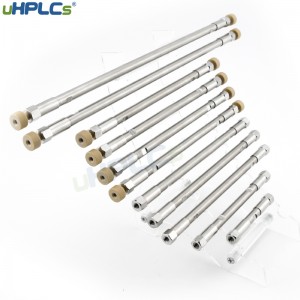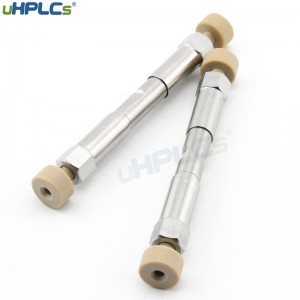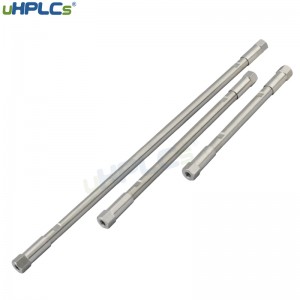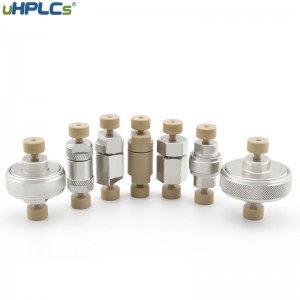Misconception 1:HPLC column can not be backflushed.
This is incorrect. In general, Liquid chromatographic columns are designed to withstand pressures well above the maximum operating pressures. When replacing the column, the backflush can clean the column head of some substances with strong adsorption properties. We flush out the residual material to prevent pressure building up. But if you buy a column that uses a larger packing at the head of the column, you will kick out this part of packing. Therefore, you should first check the liquid chromatography column you are using.
Misconception 2: All C18(L1)HPLC column is same.
This is incorrect. In early HPLC systems, C18 was the only bonded stationary phase for reverse chromatography, so C18 became the standard for reverse chromatographic columns. But the times didn’t stop. The pursuit and understanding of science became deeper, more stationary phases emerged, and many C18 columns were born. Although the same silica gel is used as the matrix, each has its own specific filler bonding synthesis process, the chromatographic performance is not the same. It’s wrong to assume that the performances between them are same.
Misconception 3: Damage occurs when air enters the HPLC column.
We all know that when HPLC column is not connected to chromatograph, we need to make sure that it is tightly sealed. But in practice, even a small amount of air entering the end of a column is not a serious thing. When the column is attached to the chromatograph, the air is squeezed out by the solvent within a short period of time during the initial pressurization of the system. So, just because a small amount of air has entered a column does not mean it has been damaged.
Misconception 4: Guard column is not necessary.
This is also an absolute misconception. There are many benefits using a guard column. HPLC mobile phase often uses a variety of reagents, which will be mixed with some insoluble substances or impure substances. Most of the insoluble matter can be removed by using a sieve plate or membrane filter to filter the moving phase, but very fine particles cannot be completely filtered. In addition, after the mobile phase modulation, there is also the possibility of insoluble and impure substances falling into the air, container, human body, etc.These insoluble and impure materials may contaminate the column, or clog the column, or adversely affect the analysis. In this case, an analytical guard column can be installed in front of HPLC column to prevent its generation and protect the column. It costs less to add or replace a guard column than to replace an expensive analysis column. uHPLCs’s HPLC guard column almost has no dead volume、easy to replace,suitable for UHPLC, hold back the strongly retained, non-adsorbable compounds. The filtration of the sample and mobile phase can maintain the adsorption capacity of the protective column to chemical contaminants, which can maintain the column for a longer time and extend the service life of the column.
Misconception 5: Pure water phase may not be used on reversed-phase chromatographic columns.
Some chromatographers have experienced phase collapse when using low organic solvent content or pure water as the mobile phase of the RP column, so some people believe that pure water phase should not be used in the RP column. However, the fact that RCP columns on the market (such as polar-embedded and polar-sealed columns) are water-wet-resistant allows the use of pure water with surface characteristics that do not cause collapse or shift in retention time.
Misconception 6:The smaller the packing size and the higher the pressure of chromatographic column filler, the better the separation effect.
The performance of chromatographic column can not be evaluated solely by the ultra-small particle size and ultra-high column pressure of the filler. In modern times, the research on the characteristics of chromatographic column is more and more in-depth, and some methods have been developed to improve the efficiency of chromatographic column. For example, columns using the new surface porous material performed as well as sub-2 m uHPLC columns and had lower column pressures than conventional LC packed columns.
Misconception 7:Column pressure does not affect the effect of chromatographic separation.
In recent years, the problem of column pressure has attracted the attention of many chromatographic workers. Many parameters of column pressure are affected by column pressure, including molar volume of partial solute, stagnant volume, column porosity, retention factor, mobile phase density, dielectric constant, stationary phase structure, pH value and ionization constant, etc. When the column was operated at about 2,000 psi(13.789MPa), even a small difference in retention time was not noticeable especially if reproducibility is good and quantification is not affected. However, the effect of column pressure can be quite significant as the column pressure approaches 2,000 psi (13.789MPa).
In recent decades, liquid chromatography has been widely used in the field of life science, drug analysis, food analysis, environmental monitoring and other fields. With the continuous study of liquid chromatography, more applications and solutions of liquid chromatography have been born. It is believed that the application of liquid chromatography will be more extensive in the future.
Post time: Mar-20-2021










